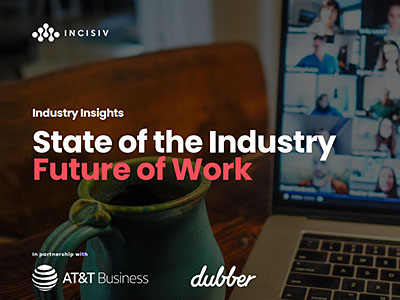Is corporate America ready for The Future of Work?
Research report on how technology can address concerns for the new hybrid workforce

Prior to March 2020, corporate human resources professionals and their bosses were in deep discussion about the next-generation workforce. This new group of workers were unique from other workers because they had different ideas both on what they valued and what motivated them in the workplace. Then, as a new reality hit for the world, these discussions ended. Workforce strategies that had been implemented were suddenly irrelevant. To complicate matters more, each month brought new challenges for how to manage employees in the remote… then hybrid, workforce.
Fast forward to January 2022. Considering all of the changes to manage – whether it’s been 1,000 or one million employees, corporate America has weathered the new normal well. But it’s also learning that even as day-to-day work slowly returns to its rhythm, the workforce strategies of the past no longer apply.
Incisiv, in conjunction with AT&T Business and Dubber, Inc., sought to understand how executives are planning to manage the workplace as offices re-open and companies return to standard operations. We conducted quantitative and qualitative research across five industries – retail, energy, healthcare, manufacturing, and banking/finance. Through this, we uncovered that that not only is a new way of work here to stay, but certain legacy thinking still exists among executives that’s contrary to what workers want. In addition, our research revealed that executives are struggling with how to protect corporate culture and maximum productivity in a way that also meets employee satisfaction in the new marketplace that’s more competitive for quality workers.
So, what does The Future of Work look like?
In fact, while the fully remote workplace model is expected to take a dramatic decline from 2021 (56%) to 2024 (19%), the hybrid model is expected to grow from 42% (2021) to 81% (2024).
- The Future of Work is hybrid – A casual discussion at a neighborhood dinner party would likely reveal that some friends love working at home and never want to return to the office. On the other hand, others miss the structure and camaraderie of the office. Most people, though, want a mix of both. That “hybrid” mix is the prevailing workplace model that most business leaders foresee as the new standard. In fact, while the fully remote workplace model is expected to take a dramatic decline from 2021 (56%) to 2024 (19%), the hybrid model is expected to grow from 42% (2021) to 81% (2024).
The difference between March 2020 and January 2022 is that in 2020, trends around the younger workforce were pointing towards the need to offer a more flexible work environment to attract and retain the best workers. In 2022, however, that applies to all generations of workers. In fact, a whopping 97% of respondents believe offering a hybrid model will help to attract better talent.
- Companies are willing, but not ready – It was unprecedented how quickly the world, and the workplace, changed. Most companies did the best they could to keep operations going both for the business and the livelihoods of their employees. Now to keep the benefits of their efforts going in their own version of a hybrid model, they’re realizing there are a number of things to consider. For example, new communications strategies, new policies, and new technologies are needed. Also, how can a business maintain company culture when employees have little to no in-person interaction and are less social?
Our research revealed that most companies have not addressed most of these issues, with 60%-75% of respondents stating that they haven't put detailed strategies for a distributed workforce to address these issues into place. Because of this, it is no wonder that 'maintaining employee oversight' was the number one challenge cited for executives managing in a hybrid model.
- Preparing for a future that’s already here – The challenges company executives face continue to become more complex. Over the next 24 months, the new workplace will be a major contributor to that complexity. As a hybrid model takes hold, executives are looking to technology to help address and simplify some of this complexity.
A good example of this is artificial intelligence (AI) and machine learning (ML). The benefits of these emerging technologies may not always be apparent in the short term; however, there are many opportunities for how they can help to better manage a hybrid workforce. In fact, according to our study, AI and ML are the top technologies that can drive positive impact in the new workplace. They’re also critical tools to enhance employee productivity.
A word of caution, though. Companies need to make sure proper infrastructure is in place to maintain and support these data-laden technologies. It’s vital that IT leaders understand the collaboration, mobility, bandwidth, security, costs, and even power requirements needed to implement these and other new technologies.
Download a copy of the report to learn more and reach out to us to discuss our findings. We’ll share strategies and use cases to prepare and optimize your business for The Future of Work.

Report: The Future of Work
Read the Incisive report on The Future of Work, created in collaboration with AT&T Business and Dubber, Inc.
Share
Share this with others